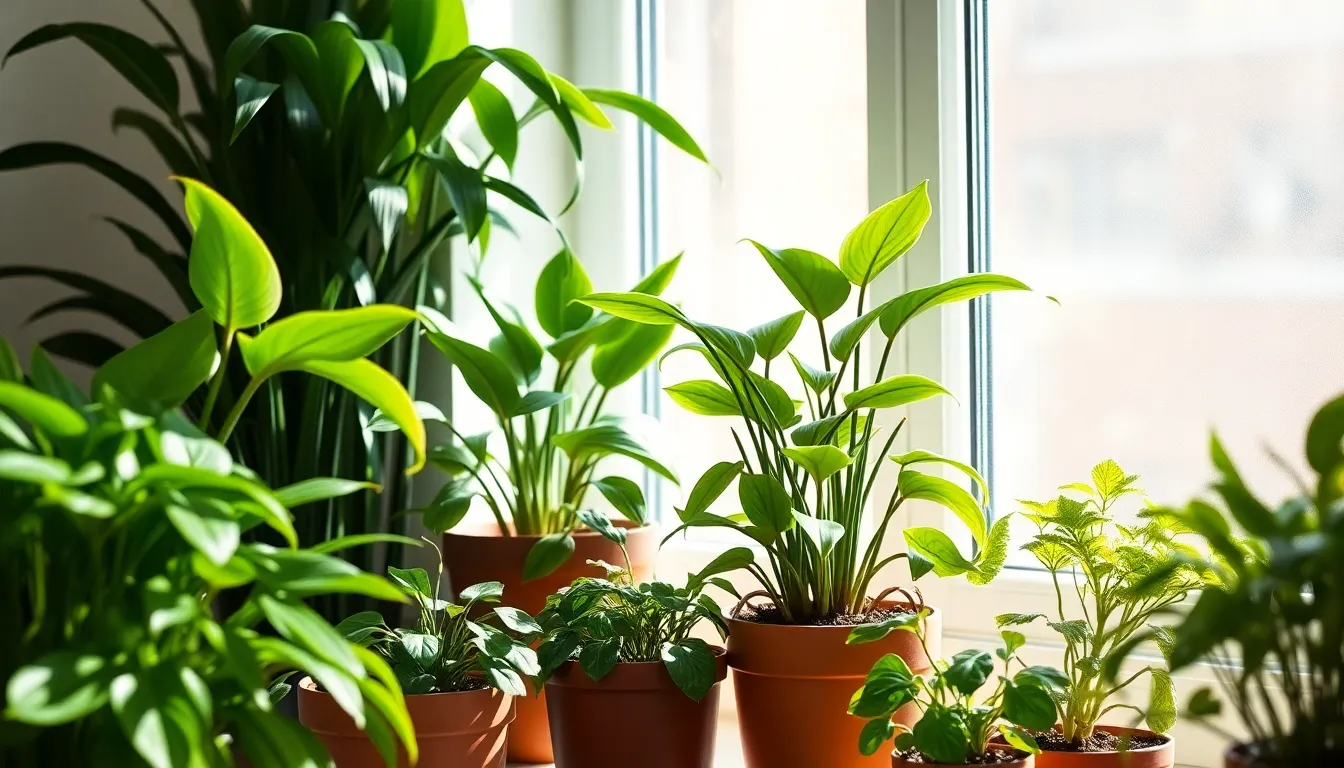Bringing a bit of green into your home doesn’t just brighten up the space; it can also boost your mood and purify the air. But for beginners, diving into the world of indoor plants can feel like stepping into a jungle with no map. Fear not, aspiring plant parent! With the right tips and a few easy-to-care-for plants, anyone can transform their home into a thriving oasis.
Indoor Plants for Beginners
Selecting the right indoor plants boosts enjoyment and eases maintenance for beginners. Numerous options exist, so understanding plant characteristics simplifies the process.
Low-Maintenance Options
Spathiphyllum, commonly known as peace lily, thrives in low light and requires minimal watering. Snake plant, another practical choice, tolerates neglect and helps purify the air. Pothos, with its attractive trailing vines, adapts to various light conditions and is forgiving of irregular watering. Zamioculcas zamiifolia, or ZZ plant, flourishes in low light and needs infrequent watering, making it an ideal option for beginners. Consider these plants for their resilience and ease of care, which fosters confidence among new plant owners.
Plants For Different Light Conditions
Bright, indirect light suits several options. For example, fiddle leaf fig flourishes under these conditions and offers bold foliage. In contrast, lower light environments often favor the snake plant and ZZ plant, both of which adapt well. For spaces with direct sunlight, succulents like jade plant and echeveria perform exceptionally well. Understanding specific light needs ensures successful plant growth, allowing beginners to choose flora that matches their home environment.
Essential Care Tips

Indoor plants thrive with proper care. Beginners can keep their plants healthy by following a few essential tips.
Watering Techniques
Watering frequency varies based on plant type and environment. For instance, snake plants prefer drier conditions, while pothos enjoy more moisture. Beginners should check the top inch of soil; if it’s dry, it’s time to water. Use room temperature water to avoid shocking the plant. Consider the season; plants may need less water during winter months. Overwatering causes root rot, a common issue for novice plant owners.
Soil and Potting Requirements
Soil quality plays a crucial role in plant health. Many indoor plants thrive in well-draining potting mixes that retain moisture without becoming soggy. For instance, pothos do well in standard potting soil, while succulents require a specialized mix. Each pot must have drainage holes to permit excess water to escape. Beginners benefit from selecting appropriately sized pots; larger pots can hold more moisture, which may lead to overwatering risks. Regularly repotting every 1-2 years ensures fresh nutrients and healthy root systems.
Common Indoor Plant Issues
Indoor plants often face specific challenges that can impact their health. Awareness of these common issues helps beginners ensure their plants thrive.
Pests and Diseases
Pests such as spider mites, aphids, and mealybugs frequently attack indoor plants. Frequent inspections can help catch infestations early. Neem oil or insecticidal soap serves as effective treatments for most common pests. Fungi and bacteria may also pose threats, causing leaf spots or mold. Maintaining good air circulation and avoiding overwatering reduces the risk of diseases. Quarantining new plants prevents potential spreads of pests and diseases.
Signs of Overwatering or Underwatering
Overwatering leads to yellowing leaves and root rot. Checking the moisture level of the top inch of soil can indicate if a plant needs water. Conversely, underwatered plants often exhibit wilting or browning leaf edges. A consistent watering schedule tailored to each plant’s needs promotes a healthy growth environment. Noticing these signs early allows for timely corrections to watering practices. Adapting to the specific water requirements of each indoor plant helps maintain their vitality.
Popular Indoor Plants For Beginners
Indoor plants can transform any space, making it more inviting and lively. Here are a few popular options perfect for beginners.
Snake Plant
The snake plant, also known as Sansevieria, thrives in various light conditions, from low to bright indirect light. This plant doesn’t require frequent watering; letting the soil dry between waterings prevents overwatering. Its striking, upright leaves provide a modern aesthetic, enhancing any room. Snake plants purify the air, removing toxins, which makes them an excellent choice for home and office environments. Maintenance involves minimal effort, making it a superb option for those new to plant care.
Pothos
Pothos plants, or Epipremnum aureum, adapt well to different light conditions but flourish in indirect light. They feature heart-shaped leaves that come in vibrant green or variegated varieties, adding a touch of color to indoor spaces. Watering is straightforward; simply check the top inch of soil for dryness. Pothos thrive in various environments, creating beautiful trails and even hanging displays. They’re known for their air-purifying qualities, contributing to a healthier indoor atmosphere. Their resilience and growth habit make them an ideal choice for beginners.
Conclusion
Embracing indoor plants can transform any space into a lively sanctuary. For beginners it’s all about selecting the right plants and understanding their care needs. Low-maintenance options like the peace lily and snake plant make the journey enjoyable and rewarding.
With the right guidance on watering techniques and light requirements even novice plant owners can cultivate a thriving indoor garden. By staying observant and proactive in addressing potential issues beginners can ensure their plants flourish. The joy of nurturing these green companions not only enhances the home but also uplifts the spirit.

